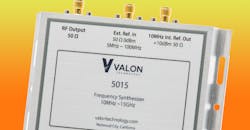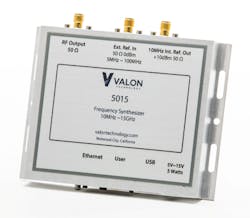Compact Synthesizer Reaches Low-Phase-Noise Levels
Miniaturization has become an increasingly important requirement in many high-frequency systems, even though the complexity of some components, such as frequency synthesizers, can be challenging to fit into a compact housing. Meeting that challenge for small synthesizers in a big way, the 5015 frequency-synthesizer module from Valon Technology tunes from 10 MHz to 15 GHz with low phase noise and spurious products. It also offers fast tuning speed in a compact housing measuring just 3.2 × 4.3 × 0.485 in.
Typical phase noise for the module is −114 dBc/Hz offset 1 kHz from a 1-GHz carrier and −138 dBc/Hz offset 1 MHz from the same carrier. The phase noise, as expected, is somewhat higher at higher frequencies, but still impressive, with −94 dBc/Hz offset 1 kHz from 10-GHz carrier and −120 dBc/Hz offset 1 MHz from the 10-GHz carrier. Spurious products are −60 dBc or less. Harmonics are typically −12 dBc.
The model 5015 frequency synthesizer module (Fig. 1) operates on a wide input voltage range of about 5 to 15 V dc, with about 6 W power consumption, thanks to an efficient, low-noise switching preregulator. The synthesizer is designed with multiple phase-locked loops (PLLs) for low phase noise. It tunes in frequency increments of 1 Hz to 4 GHz and in increments of 10 Hz at frequencies higher than 4 GHz. It locks to a new frequency in less than 100 μs.
1. This compact, lightweight frequency-synthesizer module tunes from 10 MHz to 15 GHz and measures only 3.2 × 4.3 × 0.485 in.
The 5015 offers a calibrated output power range of −20 to +13 dBm, which can be set in 0.1-dB steps, with output-power accuracy of ±0.9 dB or better. It has an output-power range of −30 dBm to better than +10 dBm from 10 to 100 MHz, better than +15 dBm from 1 to 6 GHz, and better than +13 dBm from 6 to 15 GHz.
An internal temperature-compensated crystal oscillator (TCXO) provides ±2-ppm stability over a temperature range of −20 to +70ºC. In addition, an SMA input connector will accept reference signals from any external clock from 5 to 100 MHz in 0.2-MHz increments. The 5015 can be operated with an external reference source that supplies at least −10 dBm power.
The synthesizer module can be controlled by means of Ethernet (Fig. 2), transistor-to-transistor-logic (TTL) serial, and Universal Serial Bus (USB) interfaces, with the firm offering a graphical user interface (GUI) for use with the USB connection. The device does not draw power from the USB interface, but can be powered by any 5- to 15-V dc source or an optional PS6V-1 power-supply kit, available from Valon. In addition, the Eth-01 Ethernet Adapter is also available as an accessory. It allows the frequency synthesizer to be remotely mounted as far as 8 in. from the location of the Ethernet connector, for use in bulkhead panel-mount applications.
2. The 5015 frequency-synthesizer module can be operated via a number of different interfaces, including Ethernet and USB.
The 5015 exhibits output return loss of better than 6 dB from 10 to 100 MHz, 10 dB from 50 MHz to 10 GHz, and 6 dB from 10 to 15 GHz. It weighs just 0.37 lbs, (165 g) with SMA female output connectors, and can be operated at a case temperature of 0 to +60ºC.
Valon Technology LLC, 750 Hillcrest Dr., Redwood City, CA 94062; (650) 367-1059, E-mail: [email protected].
About the Author
Jack Browne
Technical Contributor
Jack Browne, Technical Contributor, has worked in technical publishing for over 30 years. He managed the content and production of three technical journals while at the American Institute of Physics, including Medical Physics and the Journal of Vacuum Science & Technology. He has been a Publisher and Editor for Penton Media, started the firm’s Wireless Symposium & Exhibition trade show in 1993, and currently serves as Technical Contributor for that company's Microwaves & RF magazine. Browne, who holds a BS in Mathematics from City College of New York and BA degrees in English and Philosophy from Fordham University, is a member of the IEEE.



